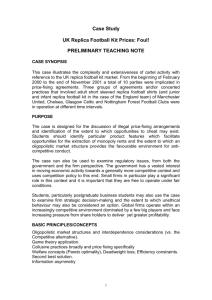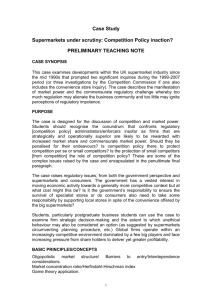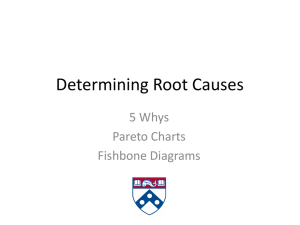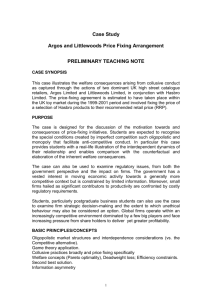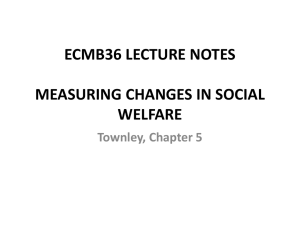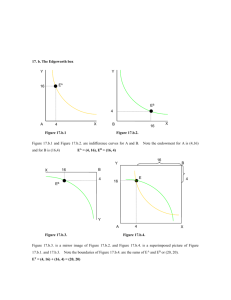Politically Determined Income Inequality and the Provision of Public
advertisement
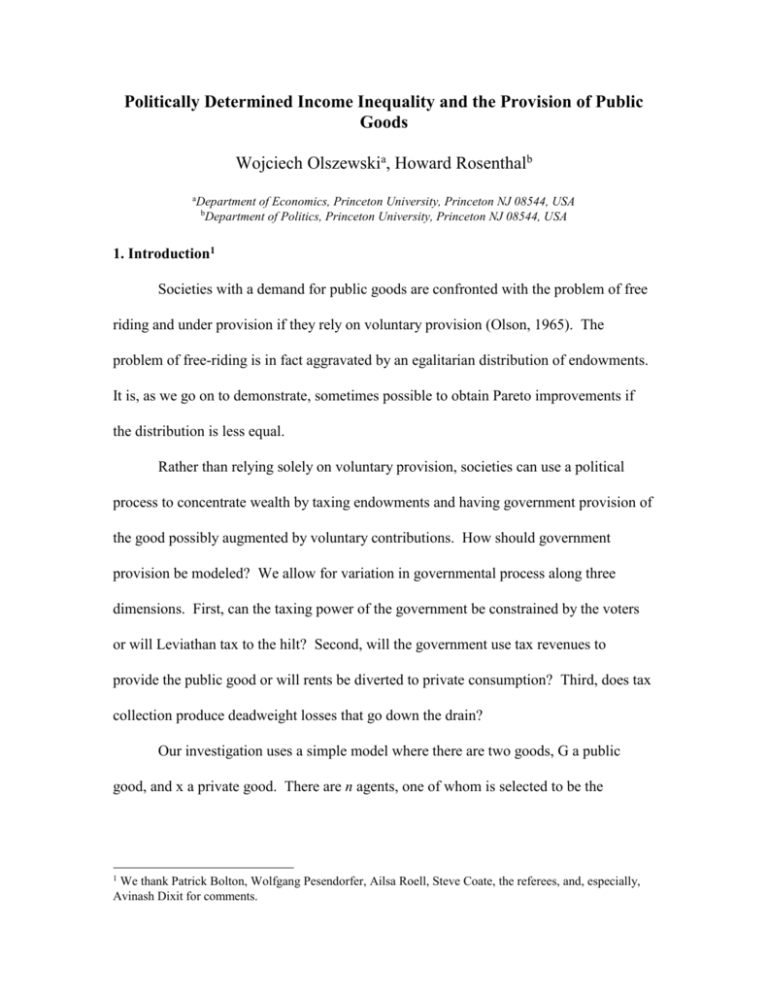
Politically Determined Income Inequality and the Provision of Public
Goods
Wojciech Olszewskia, Howard Rosenthalb
a
Department of Economics, Princeton University, Princeton NJ 08544, USA
b
Department of Politics, Princeton University, Princeton NJ 08544, USA
1. Introduction1
Societies with a demand for public goods are confronted with the problem of free
riding and under provision if they rely on voluntary provision (Olson, 1965). The
problem of free-riding is in fact aggravated by an egalitarian distribution of endowments.
It is, as we go on to demonstrate, sometimes possible to obtain Pareto improvements if
the distribution is less equal.
Rather than relying solely on voluntary provision, societies can use a political
process to concentrate wealth by taxing endowments and having government provision of
the good possibly augmented by voluntary contributions. How should government
provision be modeled? We allow for variation in governmental process along three
dimensions. First, can the taxing power of the government be constrained by the voters
or will Leviathan tax to the hilt? Second, will the government use tax revenues to
provide the public good or will rents be diverted to private consumption? Third, does tax
collection produce deadweight losses that go down the drain?
Our investigation uses a simple model where there are two goods, G a public
good, and x a private good. There are n agents, one of whom is selected to be the
1
We thank Patrick Bolton, Wolfgang Pesendorfer, Ailsa Roell, Steve Coate, the referees, and, especially,
Avinash Dixit for comments.
government. We do not model the political process as a game but simply assume that the
selected agent is a weakly Condorcet winner in the majority relation.
We consider three institutional settings. In all three, we impose the constraint that
proportional taxation must be used as the source of revenue. In the first setting, citizens
choose both the tax and the level of the public good the government can provide. In this
case, they are indifferent over which one of them is the government. In democracies,
however, citizens are perhaps able to control taxation but unable to monitor shirking in
the provision of goods and services. Therefore, in our second setting, the citizens can set
taxes but are unable to control the expenditure behavior of the “government”. The
“government” provides public goods only so far as it prefers public good provision to the
diversion of taxes as rents that augment the agent’s private consumption. In the third, the
citizens must select a Brennan and Buchanan (1980) Leviathan agent-dictator who is free
to set both taxes and the level of the public good. These three institutions are ones in
which citizen control of the government is Full, Partial, or None. Within each
institution, we allow for variation in the deadweight cost of taxation.
Can a redistribution of income within these institutions lead to an increase in the
Pareto efficiency of public good provision? Does majority voting on proportional
taxation implement efficient provision, subject to incentive compatibility constraints on
individual contributions? We address these problems in the context of the model
explored by Warr (1983), Bergstrom, Blume, and Varian (1986), hereafter BBV, and Itaya
et al. (1997). These papers explore voluntary, private provision of the public good. Itaya
et al. make the important observation that for any initial distribution of income, a less
Politically Determined Inequality and Public Goods—Olszewski, Rosenthal
2
egalitarian distribution of income leads to a higher level of welfare provided the welfare
function is symmetric and differentiable.
However, these improvements to aggregate welfare need not be Pareto improving.
Indeed, with a society of two or three individuals with identical Cobb-Douglas utility
functions of the form xG, one can readily show that no Pareto improving redistribution is
possible. In larger societies efficient redistribution is possible. Since both taxes and
voting are common mechanisms in democracies, we explore, in combination,
proportional taxation and majority rule as mechanisms for implementing Pareto
improving inequality. Cornes and Sandler (1998) considered only our Full institution.
The focus of their paper was on showing that Pareto improvement was possible for some
exogenous tax schedules. Our work is distinctive in that it considers majority voting both
on taxes and on the government.2
As a benchmark, consider the case where all citizens have equal endowments and
where there are no deadweight losses. Both the Full and Partial institutions lead to
Pareto improvement. One gets the first best with Full. With Partial, the governing agent
captures rents but provides enough public good to benefit all citizens. Leviathan, of
course, is not Pareto since whoever governs leaves the other citizens with no
consumption. These grim circumstances vanish once there are deadweight losses to tax
collection. In this case, somewhat surprisingly, there are Pareto improvements even in
the None institution.
The analysis becomes far more complex when all citizens are not created equal.
The basic problem can be illustrated by considering the case where the governing agent is
Politically Determined Inequality and Public Goods—Olszewski, Rosenthal
3
fixed and only the tax rate must be decided. With heterogeneity in endowments, citizens
will have conflicting preferences about the tax rate. For Cobb-Douglas utility under both
Full and Partial, we are able to prove a median voter theorem even though preferences
are not single-peaked. In turn, if there is a Pareto improving proportional tax, the median
voter’s most preferred tax is Pareto improving. However, for a sufficiently unequal initial
distribution of endowments, there is no Pareto improving proportional tax. In this case,
the poor are overtaxed under majority rule. Moreover, a Condorcet winner may not exist
when utility functions only obey strict concavity and monotonicity. These results indicate
that societies may find it difficult to embrace inequality that is “welfare improving.”
Under Full, the governing agent must use all taxes to purchase units of the public
good. No tax revenues can be diverted to the private good. Consequently, all agents are
indifferent as to who becomes the government and any agent is trivially a weak
Condorcet winner. The median endowment agent’s most preferred tax rate and any agent
as government are at least weakly preferred to any other tax rate, agent pair.
Under the Partial and None institutions, society selects one of its members as the
"government". The selected individual receives a transfer equal to total taxes net of any
deadweight losses. The governing agent then makes contributions to the public good that
maximize his utility. Thus, we have selfish agents who cannot commit to policies in the
spirit of Alesina (1987) and Besley and Coate (1997). Our motivation is that the selfish
agent model allows us to investigate private provision of the public good under
alternative distributions of initial income that are the result of majority voting.
2
Cornes and Sandler (1998) consider arbitrary, individual-specific taxes, lump-sum taxes, and linear taxes
whereas we consider proportional taxes.
Politically Determined Inequality and Public Goods—Olszewski, Rosenthal
4
Under Partial, citizens select a tax rate that cannot be altered by the government
and then select a governing agent. For any tax rate, the richest agent is a Condorcet
winner of the agent election. For any Condorcet winner, the level of public good
provision is that which occurs when the richest agent receives the transfers. The voters
then choose the Condorcet winning tax rate knowing that the richest agent will be the
government. We also consider simultaneous voting on tax, agent pairs.
Under None, the governing agent sets both taxes and public good expenditure to
maximize her utility function. With no deadweight loss from tax collection, selfish
agents will simply expropriate all wealth. When voting between citizen A and citizen B,
A will prefer herself, B will prefer himself, and the other citizens will be indifferent.
Therefore, all citizens are weak Condorcet winners. But if tax collection involves
deadweight losses, the indifference will be broken.
Whenever there is a strong Condorcet winner in any of our three government
institutions, that winner will be the richest citizen. The intuition for this result is that the
trick to getting Pareto improvements is in using taxation to redistribute income to one
individual. This individual then becomes, in Olson’s (1965) terminology, “privileged”
and voluntarily provides a large quantity of the public good. When the tax revenues are
added to the after-tax endowment of the wealthiest individual, this individual will provide
more of the public good than would some other individual. Consequently, the governing
agent will be the wealthiest individual. In the case of deadweight losses, there is an
additional motivation for selecting this individual. The wealthy individual has an
incentive to moderate taxes in order to avoid a deadweight loss of her own endowment.
Politically Determined Inequality and Public Goods—Olszewski, Rosenthal
5
Once a tax rate and governing agent have been selected, individuals, including the
"government", make voluntary contribution decisions in a BBV simultaneous Nash game.
(Of course, some agents may choose not to make a contribution.) When they vote, agents
anticipate the unique Nash equilibrium for every tax, agent pair.
Our setup is intended to highlight the problems of using political processes to
bring about efficient redistribution. We do not model the entire process of tax setting,
government choice, and public good production as a game. We believe that little would
be gained by exploring one or more ad hoc institutional setups for voting. We simply
note that majority voting underlies most democratic processes. Consequently, like much
of the literature (such as Bolton and Roland (1997)), we only look for median voter
results or, more generally, Condorcet winners in our political analysis. Our analysis is
otherwise limited in not considering non-linear taxes, deductibility of taxes, supermajority rule, etc., and, more generally, optimal mechanism design. These issues are left
for future research.
Our paper is related to earlier work on voting on linear or proportional taxes. In
the purely redistributive model of Foley (1967), all wealth is expropriated and after-tax
wealth is equalized. Bolton and Roland (1997) limit the amount of expropriation by
introducing costly tax collections. We adopt their specification for deadweight loss. In
both Foley and Bolton and Roland, single-peaked preferences lead to a simple majorityrule equilibrium. The model of Romer (1975), like ours, uses Cobb-Douglas utility.
Romer's government not only redistributes but also has an exogenous revenue constraint.
Taxation is limited by labor supply considerations. Preferences are not single-peaked as a
consequence of individual exit from the labor force when taxes are progressive. In our
Politically Determined Inequality and Public Goods—Olszewski, Rosenthal
6
model, taxation can be limited not only by deadweight losses but also by individual
interest in maintaining private consumption and by the "government's" inability to
commit to using all taxes to produce the public good. Preferences are not single-peaked
as a consequence of individuals becoming free riders as they exit from the set of public
good contributors.
2. The Economic Environment
The BBV economy has a private good, x, a public good G, and n agents, n odd.3
The endowment of agent i is wi which can be allocated either to private consumption xi or
to public consumption gi. That is, wi = xi + gi, and G = igi is the common consumption
level of the public good. W.l.o.g., assume 0 < w1 … wn. Denote aggregate wealth by
W = iwi. In this section, we assume each agent has the same utility function u = xG.4
We assume a proportional tax system such that every agent i is taxed twi. The amount of
revenue raised is t(1-t)W. This is the Bolton and Roland (1997) specification of
deadweight loss from taxation. When =0, there is no loss. When =1, no revenue can
be raised when the tax rate reaches 1. We consider only these two extreme cases.5
Assume agent n is the “government” and post-tax endowments are (1-t)wi, i
=1,…, n-1 and tW(1-t) + (1-t)wn, i=n, where W = iwi. Then, agents choose gi
simultaneous Nash. In the Full setting, agent n must satisfy the constraint gn tW(1-t).
3
The assumption of n odd is solely to simplify the discussion. The assumption is not fundamental to the
analysis.
4
The generalization to any Cobb-Douglas utility function is direct.
5
Results, however, hold even for > 1.
Politically Determined Inequality and Public Goods—Olszewski, Rosenthal
7
In the Partial and None settings, agent n is unconstrained. BBV prove this game has a
unique Nash equilibrium. Throughout the paper, we take advantage of the following
equilibrium property of the BBV model coupled with our specification u=xG.
Result 1
gi > 0 xi = G; gi=0 xi < G
That is, for agents who contribute to the public good, private consumption equals
consumption of the public good.
Pareto improvements with transfers to agent n are clearly possible. Suppose w1 =
… = wn , n > 3. Then if t=0, the Nash equilibrium utility of all agents can be shown to
be:
nw
u0
n 1
2
In the Partial and Full settings, given t and , the utility of agents i =1,…,n-1 will
be at least:
u t , (1 t ) w
(1 t ) w (1 t )tnw
2
In turn, for sufficiently large n it will be the case that
u t , a u 0 for all 0 t 1, 0 1 .
To show that Pareto optimal improvements are possible for large n in equilibrium,
we must further show that t remains appropriately bounded away from 1. Later in the
paper, we show that, as societal wealth increases, for any distribution of income, the
political process leads to Pareto improvement unless =0 in the None situation.
3. Taxation In the Absence of Deadweight Losses
Politically Determined Inequality and Public Goods—Olszewski, Rosenthal
8
In this section, we continue to assume that agent n is the government. We further
assume that there are no deadweight losses to taxation.
In the None setting, agent n obviously sets t=1 and maximizes u by setting
gn=W/2=G. Slightly more generally:
Result 2. When there are no deadweight losses (=0), in the None setting, the
agent who is the dictator choose t=1.
The Partial and Full cases are highly similar. Rent diversion in the Partial
setting means that this case has fewer opportunities for Pareto improvements.
Nonetheless, in both cases, improvements are possible, even for n small.
Suppose w1 = … = wn , n > 3.
In the Full setting, the first best can be obtained by setting t=1/2. In this case,
gi=0 for all i and G=W/2.
In Partial, there is strict Pareto improvement over t=0 for any t (1/(n+1), (n2-2n1)/(n2-1))
. There are, however, two problems. First, we have arbitrarily made agent n the
provider. Second, agent n’s preferences and those of the other agents are in conflict over
the Pareto improving tax rates. Agent n would like the largest possible tax rate. The
other agents would prefer t* = (n-2)/[2(n-1)]. For the moment, we ignore the first
problem and concentrate on a political equilibrium for the tax rate. In the example of
equal initial endowments, there is a straightforward political equilibrium. Agents 1, …,
n-1 have identical preferences and impose t*. The Condorcet winner is Pareto improving.
We now study the general case where initial endowments are not all equal.
Politically Determined Inequality and Public Goods—Olszewski, Rosenthal
9
When endowments are unequal wealth effects will introduce additional conflict
over the tax rate in the Full as well as the Partial case. The main results of this section
hold for both settings.
Let gi(t) be i's BBV equilibrium contribution when the tax rate is t. In the
Appendix, we are able to show, through Lemma 1, that the induced preferences on taxes
have the following properties:
1. The agents are numbered in (weakly) increasing order of endowments.
2. The cutoff levels ti above which agent i is constrained in Nash equilibrium (gi(t) = 0)
are ranked in increasing order of endowment.
3. Utilities of unconstrained agents (gi(t) > 0) are weakly monotone increasing on t in
[0,t1] and strictly increasing on [t1, ti].
4. Utilities of constrained agents are proportional to endowments.
5. Utilities are continuous in t.
These five properties are, for all purposes, identical to those for an oligopoly
problem studied by Cave and Salant (1987). Although our basic model is different—in
particular there are no transfers among producers in the Cave and Salant model, Lemma 1
establishes that we can largely follow their proof of the “Median Packinghouse Theorem”
in proving our main results. Any Condorcet winner is a tax rate that maximizes the utility
of the citizen with the median endowment. In turn, if Pareto improvement is possible, the
Condorcet winners are Pareto improving.
Theorem 1. Median Endowment Theorem. The set of Condorcet winners is the
set of the median endowment agent's most preferred tax rates.
Politically Determined Inequality and Public Goods—Olszewski, Rosenthal
10
Proof: See Appendix.
Remark. It can be shown (proof omitted) that preferences on t are value-restricted (Sen,
1970). Therefore, the majority relation is quasi-transitive.
Theorem 2. There exists a Pareto improving t > 0 iff every most preferred tax rate
c for the median agent is Pareto improving.
Proof: See Appendix.
We have established that if proportional taxation can be Pareto improving, the
majority rule equilibrium is Pareto improving. On the other hand, when initial wealth is
too dispersed, no Pareto improvement is possible. The majority rule equilibrium harms
the poorly endowed. We now provide four illustrative examples.
Example 1. Partial setting, n=5, w1=w2=w3=w4=w5=20. In this case, agent 3’s most
preferred tax rate is 3/8, G=30, and the outcome is Pareto improving. The median voter
does not set the first-best tax rate of 0.5 because agent 5 will not produce 50 units of G
but instead diverts some transfers to private consumption.
Example 2. Partial setting, n=5,w1=10, w2=15, w3=20, w4=25, w5=30. This example is
illustrated in figure 1. Agent 3’s most preferred tax rate is now only 1/21, with G=100/21.
At this (and every strictly positive) tax rate, agents 1 and 2 are worse off than at t=0.
Intuitively, agent 3 sets a low tax rate because agents 4 and 5 contribute more to the
public good than they do when endowments are equal. Note further that the figure
illustrates that preferences are not single-peaked.
Politically Determined Inequality and Public Goods—Olszewski, Rosenthal
11
Example 3. Full setting, n=3, w1<w2=w3=30. In this example, the median voter sets
t=1/2. But this tax is Pareto optimal only if w120. Otherwise, the poor individual
prefers no taxation. When t=1/2 is Pareto optimal with respect to t=0, it is also a first best
in that it is Pareto with respect to all other tax rates.
Example 4. Full setting, n=3, w1=w2=1, w3=30. For this highly skewed income
distribution, the median endowment agent sets t=0. The example illustrates that t=1/2 is
not always the voting outcome. The poor are content to live with the voluntary provision
of the rich.
Examples 3 and 4 suggest that a first best outcome is possible if the endowment
distribution is not too heterogeneous. In fact:
Theorem 3. In the Full setting, if the median endowment agent sets t=1/2 and t=1/2 is
preferred by agent 1 to t=0, t=1/2 maximizes the utility of all agents i=1,…,n.
Proof: See Appendix.
4. Voting Cycles with More General Utility Functions
In this section we shall show that, unlike u=xG, for an arbitrary smooth,
monotonic quasi-concave utility function satisfying standard assumptions, the majority
relation need not be quasi-transitive. Voting cycles exist. The Appendix extends this
result to show that there need not be a Condorcet winner, even when both goods are
normal. We deal only with the Partial case since the Full case is similar.
Politically Determined Inequality and Public Goods—Olszewski, Rosenthal
12
Consider three agents with wa = 100, wb = 200, wc = 1000. Further consider three
tax rates t1 = 0.00, t2 = 0.03, t3 = 0.06. Suppose that u(x,G) has the property that agent c
chooses
C1 = ( 950,50) for t1, C2 = (952,57) for t2 = .03 , and C3 = (953,65) for t3.
(1)
Next let A1 = (100,50), A2 = (97,57), A3 = (94,65), B1 = (200,50), B2 = (194,57), and
B3 = (188,65). Assume that:
u(A1) > u(A3) > u(A2) , u(B2) > u(B1) > u(B3) .
(2)
Given our choice of parameters there is a monotonic quasi-concave utility function that
both satisfies (2) and has indifference curves passing through A1, A2, A3, B1, B2, B3 that
are steeper than the budget constraint at those points. (The constraint xa(0) + G(0) = 100
+ 50 passes through A1, etc.) Hence,
ga = gb = 0
for t1, t2, t3
(3)
Thus, we have constructed a utility function and consumption pairs in a manner that
equations (1) and (3) are mutually consistent.
We have u(C3) > u(C2) > u(C1) by (1), and u(B2) > u(B1) > u(B3) , u(A1) > u(A3)
> u(A2) by (2). Therefore, there is a majority cycle over t1, t2, t3.
The results in this section and the Appendix establish that, even if increasing
inequality is Pareto optimal, it may be difficult for societies to choose a Pareto optimal
tax rate in the sense that there is no Pareto optimal t>0 that is a Condorcet winner.
5. Voting on the "Government" in the Absence of Deadweight Loss.
Politically Determined Inequality and Public Goods—Olszewski, Rosenthal
13
In this section we again assume u=xG. One agent is to be designated as the
government who will receive the transfers from the tax voted in the first stage. The Full
and None cases are trivial. In Full, the governing agent has no discretion. Consequently
all voters are indifferent about who becomes agent. Under None, every agent would like
to be the dictator but is indifferent between other individuals as dictator. Consequently,
in a vote between agent A and agent B, only B strictly prefers B to A so A is weakly a
Condorcet winner. Every agent is a weak Condorcet winner.
The interesting case for government selection is Partial. When voting on which
agent will become the “government”, agents take the tax rate as fixed at t and anticipate
the unique Nash equilibrium that results were some agent j to receive a transfer of tW.
Let a policy be represented by a pair (t,i) where t denotes the tax rate and i the designated
individual receiving the transfers. Under any policy recall that agents choose
simultaneous Nash after the transfers have been made.
We show that agent n must be in the set of Condorcet winners for the agent election.
Moreover, any other Condorcet winner must have the same level of G that results when n
receives the transfers. In brief, the public goods outcome will be the level of G that
would occur were the richest agent the government.
Theorem 4. The set of Condorcet winners in the agent election are agent n and
any other agents whose election would result in G equal to the level produced when n
receives the taxes.
Proof. Follows directly from Lemmas 3 and 4 in the Appendix.
Politically Determined Inequality and Public Goods—Olszewski, Rosenthal
14
This section and section 2 establish that, for Cobb-Douglas utility, there is a
majority rule equilibrium when society votes sequentially on the tax rate and the agent
receiving the transfers. When the tax rate and the designated agent are determined in a
simultaneous vote, it is possible to defeat the outcome where agent n is the designated
agent and the tax rate is a preferred tax rate of the median endowment agent. Consider
the endowments of Example 2. Agents 4 and 5 would prefer a higher tax rate than the
median agent, agent 3. They can "bribe" 3 into accepting a higher tax rate. For (1/5,3),
agents 3, 4, and 5 receive higher utility than with (1/21,5). In turn, (1/5,3) is defeated by
(1/5,5), which is defeated by (1/21,5). So voting simultaneously on the tax rate and the
agent can lead to voting cycles. However, an extremely mild form of super-majority rule
guarantees the stability of outcomes.
Theorem 5. At most m=(n+1)/2 individuals strictly prefer any (t,i) to (c,n) where
c is a most preferred tax rate of agent m (the median voter) when n is the "government".
Proof. See Appendix.
That is, (c,n) is stable if it must be defeated by more than a one-vote margin.
6. Deadweight Loss from Taxation
In the Full and Partial institutions, Theorems 1, 3, and 4 continue to hold.
Having deadweight loss does not help to bring about Pareto optimal shifts from t=0. We
only sketch the argument, using figure 1 to help with the intuition. For every t, the utility
of every individual must fall as deadweight loss increases. That is, the curves in figure 1
shift down. Denote the equilibrium tax rate with deadweight loss by cdead. Agent 1’s
Politically Determined Inequality and Public Goods—Olszewski, Rosenthal
15
utility at cdead for > 0 will be less than her utility at cdead for =0. If gm = 0 at cdead for
=0, agent 1’s utility at cdead for =0 is less than her utility at c for = 0. If, on the other
hand, gm > 0 at cdead for = 0, agent 1’s utility at cdead for =0 will be less than her utility
at t=0 by lemma 2. So deadweight loss will make the poorest agent worse off under
either Partial or Full.
The more interesting situation is that of None. When the government enjoys full
discretion and taxation causes no inefficiencies, we showed that the Leviathan’s optimal
tax rate is 1 and all other citizens suffer with respect to t=0. We now demonstrate that a
deadweight loss from taxation can paradoxically restore Pareto improving outcomes.
There is a parallel to our previous results in that the richest individual is the unique
Condorcet winner among possible dictators.
We assume here that =1. The results will go through for other values of . Tax
revenue is no longer equal to tW , but becomes (1-t)tW.
For the moment consider the case where agent k is the Leviathan and the only
agent who chooses to contribute to the public good. In this case, agent k provides:
gk(t) = Gk(t)=[(1-t)wk + (1-t)tW]/2
given the tax rate t, and chooses t to maximize u(xk(t),g(t)) = [gk(t)]2 . That is, the tax rate
when k is a dictator is
tk = (W-wk)/(2W)
and the public good is provided at level
Gk = [wk+W]2/(8W).
Note that k's utility is u= [Gk]2. Our dictator takes into account the deadweight
loss from taxing his own income. This becomes unimportant as aggregate wealth grows
Politically Determined Inequality and Public Goods—Olszewski, Rosenthal
16
and tk approaches ½. That is, for large W our dictator is a Brennan and Buchanan (1980)
revenue maximizer.
Observe that, if k > j, agent k chooses a lower tax and provides more public good
than does j. Therefore if only the dictator provides the public good, then
for any i k, j and k > j, agent i prefers k to j as dictator. In turn, the extremely mild
assumption that
wn-1 < [wn+W]/(8W)
(A1)
guarantees that if n is dictator, n will be the only contributor. Indeed agents i < n have no
incentive to contribute as their post-tax income (1-tn)wj is lower than Gn by A1. On the
other hand the dictator has no incentive to decrease the tax rate. Why? The dictator could
either seek to encourage private contributions by other citizens or to remain the only
provider. In the latter case agent n is obviously worse off than with her optimal dictator's
tax rate. She also cannot obtain higher utility in the former case. If at least one other
citizen contributes, n-1 will contribute and n must continue to contribute. But n's
consumption of the private good and the public good must both be less than wn-1 or else
n-1 will not contribute by result 1. Her utility is not greater that [wn-1]2 < [Gn]2 by virtue
of A1. With another assumption similar to (A1), it can be shown that the voters prefer n
as dictator to some k<n who would set a tax rate where k is not the sole contributor.6
Thus n as dictator is the unique Condorcet winner.
We have proved the following:
Theorem 6. When =1, the richest individual is chosen as the None dictator.
6
The assumption is that wj < [wk+W]/8 for any k and j.
Politically Determined Inequality and Public Goods—Olszewski, Rosenthal
17
Example 5. In the case of equal endowments, the dictator provides (n+1)2w/(8n) units of
the public good. So every non-provider's utility is (n+1)3w2/(16n2) which exceeds the
equilibrium utility n2w2/(n+1)2 for t =0 provided n>9. Obviously, the dictator is better off
too.
The example shows that, for some initial distributions of income, the dictator will
choose taxes and expenditures that are Pareto optimal with respect to t=0.
7. Pareto Optimality in Large Societies
Our political processes are always Pareto optimal in large societies, except when a
Leviathan can collect taxes without deadweight loss. To model large societies, we
assume:
The minimum endowment, w1, is constant for all W; as W, wn/W0.
(A2)
From the last section, note that as W increases tn approaches ½. The utility of the
poorest individual approaches ½w1W/8. Note that if every citizen had endowment wn, G
for t=0 would approach wn as W. This G is greater than the G that would be
produced by the actual society. So the poorest individual’s utility at t=0 must be less than
w1wn. So clearly the poorest individual is better off with Leviathan. In fact, for
sufficiently large W, the poorest individual is better off with Leviathan for any >0.
Consider now the Full and Partial settings. Assume the median endowment agent
acts as if there will be no additional contributions to the public good beyond government
provision in Full and that only agent n will contribute in Partial. It is straightforward to
Politically Determined Inequality and Public Goods—Olszewski, Rosenthal
18
show that the tax will vary from ½ for = 0 to 1/3 at = 1 for W large. Since G is large
for W large, no agent contributes by result 1, except for agent n in Partial. Thus for any t
(0,1), every agent will be better off than at t=0 for W sufficiently large. . We have
proved:
Theorem 7. For W sufficiently large and (A2), the outcome of the political process is
Pareto optimal with respect to t=0, unless the setting is None and = 0.
8. Conclusion
With Cobb-Douglas utility, for any tax rate t, the Condorcet winner in the political
process for selection of the “government” will essentially be the richest agent under the
Partial institution and under the None institution with deadweight loss. In the other
scenarios, the identity of the agent is unimportant. In the first stage of voting under
Partial, voters will anticipate n’s selection and choose the Condorcet winning tax rate we
indicated in section 2. We have shown that there is a class of utility functions where
majority rule might be used to increase the production of public goods. If the initial
distribution of wealth is fully egalitarian, as we showed earlier, the outcome of the
political process is Pareto improving. However, if the initial distribution is sufficiently
unequal and the size of the economy is small, the political process need not result in
Pareto improving transfers.
Our examples show how our contribution amends Itaya et al. (1997). Increasing
inequality may be “welfare” improving but it is not necessarily Pareto improving.
Political processes may impose non-Pareto redistributions or, for certain utility functions,
Politically Determined Inequality and Public Goods—Olszewski, Rosenthal
19
be unstable. Political problems remain even when the citizens are able to exercise full
control over both taxes and expenditures. Differences in initial endowments are the
fundamental source of political conflict.
Problems of political conflict vanish when voters are constrained to use the None
institution in the presence of deadweight loss. While each individual would prefer to play
the Leviathan role himself, he otherwise prefers that the transfers go to the richest agent.
One might believe that government is "bad", even when it comes to externalities,
because the inefficiencies associated with government will prove more costly than the
market failure. But our None institution with deadweight loss is a worst case scenario.
The governing agent is a pure rent seeker with dictatorial powers. A substantial amount
of the society's resources are thrown away in deadweight losses in tax collection.
Nevertheless, for large n, citizens can unanimously prefer Leviathan to the anarchy of
purely voluntary provision.
Leviathan, however, is inefficient. Societies can do better with partial or full control
of the taxing and spending powers of government. The problem of providing for more
efficient production of public goods within a framework of voluntary contribution
remains open to further analysis.
APPENDIX
Let G(t) denote the consumption of the public good in the equilibrium for tax rate t.
Let xi(t) and vi(t) be i’s consumption of the private good and utility respectively.
Lemma 1. In the Full and Partial settings:
(a) For every i = 1, …, nmax there is a ti such that gi > 0 iff t < ti, with 0 t1 … tn-1 < 1.
Politically Determined Inequality and Public Goods—Olszewski, Rosenthal
20
(b) v1, …, vn-1 are constant on [0, t1], and vi is strictly increasing on [t1, ti] for i = 2, …, nmax
.
(c) Let i > j . Then vi(t)/vj(t) = wi/wj for t [ti,1).
(d) vi(t) is continuous on t.
(e) nmax = n-1 in Partial and n in Full.
Proof. Note that i’s Nash best response can be characterized as choosing xi(t) and
G(t) subject to xi(t) + G(t) = (1-t)wi + G-i(t) and G(t) G-i(t), where G-i(t) =jigi in the
Partial setting and G-i(t) = tW + jigi in the Full setting.
We shall first show that if s t , then G(s) G(t) .
Suppose s > t but G(s) < G(t). By result 1 those agents who contribute under t spend more
on private consumption under t than under s ( because G(t) > G(s) ). Those agents who do
not contribute under t spend more on private consumption under t than under s because
(1-t)wi > (1-s)wi. Therefore the total spending on both private consumption and the public
good are greater under t than under s, a contradiction.
(a) Observe that if agent i contributes, then any agent j i contributes as well.
Indeed, suppose gi > 0 but gj = 0. This implies (1) there is an indifference curve of u
tangent to i’s budget constraint at (xi(t),G(t)) , where xi(t) < (1-t)wi ; and (2) the
indifference curve of u through ((1-t)wj,G(t)) is steeper than j’s budget constraint. But
(1), (2), and the assumption that wi wj can easily be used to contradict the normality
of u.
Next assume that gi = 0 for some t, but gi > 0 for some s > t. The assumption
and G(s) G(t) lead to contradiction of the normality of u.
Politically Determined Inequality and Public Goods—Olszewski, Rosenthal
21
(b) Since the total spending on private consumption and the public good must
be constant for every t, the public good provision and the private consumption of each
agent are uniquely determined by result 1 and are independent of t whenever gi > 0 for
all i. Thus, for all i, vi must be constant over t [0, t1].
The second part can be proven separately for every non-degenerate [tj, tj+1] ,
where 1 j < i . Within each such interval, the consumption of public good and the
total private consumption of all i such that gi > 0 is an increasing function of t. Result
1 then implies that vi is strictly increasing.
(c) By (a) gi = gj = 0 for t [ti,1). This implies vi(t) = (1-t)wiG(t) =
[wi/wj]vj(t).
(d) Obvious. Proof omitted.
Remark. Notice that in the Partial setting agent n always contributes to the
provision of the public good and vn is constant on [0,t1] and strictly increasing on [t1,1].
Proof of Theorem 1
Let C stands for the set of the median agent's most preferred tax rates. Notice that C can
contain more that one element as preferences are not single-peaked.
1. By the continuity of v the set C is non-empty.
2. By property 3 in the text, there is a c C such that c tm.
3. By property 4, all non-contributors have proportional preferences over those tax rates
for which they do not contribute. Therefore, by property 2, all i m will prefer c to any t
> c, t C. Consequently, all such t are defeated in a majority vote.
Politically Determined Inequality and Public Goods—Olszewski, Rosenthal
22
4. Consider agents i > m. For ti t < c, t C, since m prefers c to t, i strictly prefers c to
t by properties 2 and 4. Agent i also strictly prefers ti to t < ti by property 3.
Therefore, by transitivity of individual preferences, agent i prefers c to all t < c, t C.
Consequently, all such t are defeated by majority vote.
5. The preceding two steps establish that all t C are defeated by any c C such that c
tm .
6. By property 4 all agents i m are indifferent between any two elements of C such that
c tm .
7. By property 3 there is a c C such that c < tm only if tm = t1 > 0 . Then all agents are
indifferent between any two elements of [0, tm].
Lemma 2. In the Full and Partial settings:
v1(0) v1(t) for all t (0,tm) (all t> 0 such that the median agent contributes).
Proof:
Agent 1’s utility is constant for t<t1.
For t1 t tm, between any two cutpoints ti,ti+1,
v1/t = (w1/(n-i+1))[-Wc + (1-2t)Wnc] in the Partial setting,
and v1/t = (w1/(n-i+1))[-2Wc + (1-2t)(Wnc+ Wc)] in the Full setting,
where Wc denotes the wealth of contributors i+1,…, n and Wnc the wealth of noncontributors 1, …, i.
Since the wealth of individuals at or above the median must exceed that of those
below, the derivatives must be negative for i < m. The lemma is then established by
noting the continuity of v1.
Politically Determined Inequality and Public Goods—Olszewski, Rosenthal
23
Proof of Theorem 2
1. It can be easily proved that a tax s is Pareto improving iff v1(s) > v1(0).
2. By lemma 2, v1(s) > v1(0) implies s > tm.
3. But for all t > tm, agents 1 and m have identical preferences by property 4.
4. Therefore, if 1’s utility is not maximized by t=0, it is maximized by c.
Proof of Theorem 3
1. Observe that there is no private contribution to the public good provision at t =1/2.
Indeed, xi = (1/2)wi and G=(1/2)W, so xi < G and result 1 applies.
2. In this step we show that t=1/2 maximizes the utility of agent 1.
By lemma 2 the utility of agent 1 is maximized either at t=0 or at t tm . By our
assumption that agent 1 prefers t=1/2 than t=0 it must be maximized at t tm. But at that
interval the preferences of agents 1 and m are proportional by Lemma 1 (c).
3. In this step, we show that t=1/2 maximizes the utility of any agent i.
Indeed, xi(t)G(t) (1-t)wiG(t) = [wi/w1](1-t)w1G(t) = [wi/w1]x1(t)G(t) [wi/w1](1/4)w1W
= (1/4)wiW = xi(1/2)G(1/2) for every t t1 . For t t1 the utilities of agents 1 and i
coincide.
Lemma 3. In the Partial setting:
(a) If G is greater for (t,n) than for (t,j), n defeats j by at least a vote of n-1 to 1.
(b) If G is equal for (t,n) and (t,j), agents other than n and j are indifferent in a vote
between n and j.
Proof.
Politically Determined Inequality and Public Goods—Olszewski, Rosenthal
24
(a) Step 1 establishes that agent n is strictly better off. Steps 2-5 pertain to agents i =
1,…,n-1.
1.
Under (t,n), gn>0. Since G is greater under (t,n) than under (t,j), by normality of x
and G, agent n is strictly better off under (t,n) than under (t,j).
2.
If gi > 0 both for (t,j) and (t,n), agent i is strictly better off under (t,n) by normality
of x and G, and the assumption that G is greater for (t,n) than for (t,j).
3.
If gi > 0 under (t,n) but gi = 0 under (t,j), G-i for (t,n) must be greater than for (t,j).
If not, since the after-tax wealth of i under (t,n) is not greater than under (t,j), the
budget constraint under (t,n) would fall below that under (t,j), implying that gi = 0
under (t,n). Since G-i is greater under (t,n) i would be strictly better off with gi =
0 under (t,n) than under (t,j). Therefore, i must also be strictly better off with gi >
0 under (t,n) than with gi = 0 under (t,j).
4.
Agents with gi = 0 under both (t,n) and (t,j) have equal private consumption under
(t,n) and (t,j) but higher G for (t,n). Consequently, these agents are strictly better
off under (t,n).
5.
If gi > 0 for (t,j) but gi = 0 for (t,n) and i is at least as well off under (t,j) and under
(t,n), agent i must have greater after-tax wealth under (t,j). Otherwise, both G and
xi are less under (t,j) than under (t,n). Consequently, this agent must be j.
(b) The proof is omitted since it is analogous to the proof of part (a).
Lemma 4. In the Partial setting.
Every agent i j is at least weakly better off under (t,n) than under (t,j)
Proof.
Politically Determined Inequality and Public Goods—Olszewski, Rosenthal
25
If gn > 0 for (t,j), by Theorem 4 (i) and (ii) in BBV, G under (t,n) must be greater than or
equal to G under (t,j). If gn = 0 for (t,j), than gi = 0 for all ij and therefore gi = 0 for all i
n under (t,n). Thus G must not be smaller for (t,n) than for (t,j). The lemma follows
directly from lemma 3.
Proof of Theorem 5.
By theorem 1, at least m individuals weakly prefer any (c,n) to any (t,n). In turn,
by lemma 4 at most 1 of these does not weakly prefer (t,n) to (t,i). By the transitivity of
individual preference, at least m-1 individuals weakly prefer (c,n) to (t,i). This implies
that at most m strictly prefer (t,i) to (c,n).
Politically Determined Inequality and Public Goods—Olszewski, Rosenthal
26
The absence of a Condorcet winner for normal goods.
We shall first show that there is a monotonic quasi-concave utility function u
satisfying conditions (1)-(3) from Section 3, such that both x and G are normal goods.
Consider a smooth curve L such that ( see Figure 2):
(a) its slope increases from - for x tending to 0 to –8/3 at A3 = (94,65),
(b) its slope increases from –8/3 at A3 to –5/2 at its intersection D = (xD,GD) with the
horizontal line G = 50,
(c) its slope increases from –5/2 to –7/6 as x increases from xD to some xD + ,
(d) its slope increases from -7/6 to -1 as x increases from xD + to xD + 7 + ,
(e) its slope increases to 0 for x tending to .
Denote by C the point on L whose x-coordinate is equal to xD + 7 + ( that is, the
point at which the slope of L is equal to –1 ), and by E the point whose x-coordinate is
equal to xD + 6 + , and by F the point whose x-coordinate is equal to xD + .
For (x,G) below L, u is defined as a homogeneous function such that L is one of
its indifference curves. Above L, u is determined by its indifference curves{ Lt : t 0 } ,
where Lt = L + (x(t),G(t)). That is, a point x, G on L is mapped to a point x+x(t), G+G(t)
on Lt. Assume that:
(f) x(t) and G(t) are strictly increasing and tend to as t tends to ,
(g) { C + (x(t),G(t)) : t 0 } passes through C1, C2, and C3,
(h) { E + (x(t),G(t)) : t 0 } passes through B1 = (200,50) .
Politically Determined Inequality and Public Goods—Olszewski, Rosenthal
27
By construction and assumptions (a), (e), and (f), u is a well-defined monotonic,
quasi-concave function, and both x and G are normal goods. By (g) condition (1) is
satisfied. Since L passes through A3, A2 lies below L, and A1 lies above L (see (b)), the
first part of (2) is satisfied. Consider Lt that passes through B1. Since its slope is higher
than –7/6 for every x (194,200) (see (h) and (d)), B2 = (194,57) lies above Lt. Since its
slope is lower than –5/2 for every x < 194 - (see (c) ), B3 = (188,65) lies below Lt
provided is sufficiently small. Thus the second part of (2) is also satisfied. Condition
(3) was satisfied by construction.
Now we shall generalize the result from Section 3 and prove that no t [0,1] is a
Condorcet winner. Assume additionally that:
(i) { C + (x(t),G(t)) : t 0 } coincides with segment C1C2 between C1 and C2, and with
the segment C2C3 between C2 and C3,
(j) the slope of { C + (x(t),G(t)) : t 0 }at any point with coordinates greater than C3 is
lower in magnitude than an arbitrarily small ,
(k) for the t that B2 Lt, B2 = (194,57) lies between D + (x(t),G(t)) and F+ (x(t),G(t)).
By (i) agent a’s ( b’s ) equilibrium bundle moves from A1 ( B1 ) to A2 ( B2 ) along
segment A1A2 ( B1B2 ) for t increasing from 0 to .03, and then from A2 ( B2 ) to A3 ( B3 )
along segment A2A3 ( B2B3 ) for t increasing from .03 to .06. Notice that A2A3 lies
below L by virtue of (b), and intersects L only at A3, so every t (.03,.06) is defeated by
t3. Agents a and c prefer t3. So is every t from a sufficiently small neighborhood of .03.
If is sufficiently small, that any t > .06 can also be defeated by t3, because agents a and b
prefer t3 (see (j)). Since the slope of L at D is –5/2 < -8/6 and the slope of L at F is –7/6,
Politically Determined Inequality and Public Goods—Olszewski, Rosenthal
28
the optimal tax rate s for agent b belongs to as small neighborhood of .03 as one wishes
provided is sufficiently small (see (k)) so s is defeated by t3. By (2) however t3 can be
defeated by t1. Finally s defeats t for every t < s, because agents b and c prefer s than t.
One can easily modify our construction to obtain a smooth u.
Remark. If we additionally assume that:
(l) for the t that A1 Lt, A1 = (100,50) lies between F + (x(t),G(t)) and E + (x(t), G(t)),
then every sufficiently small t > 0 Pareto dominates t1 = 0. Thus increasing inequality is
Pareto optimal, but there is no Condorcet winner.
In a similar manner, one can define a utility function u such that and endowments
wa, wb, wc, c, such that the most preferred tax rate of agent b is uniquely determined, is a
Condorcet winner, but is not Pareto improving although there are Pareto improving tax
rates t > 0.
Politically Determined Inequality and Public Goods—Olszewski, Rosenthal
29
References
Alesina, A., 1987. Macroeconomic policy in a two-party system as a repeated game.
Quarterly Journal of Economics, 102:651-678.
Bergstrom, T. C., Blume, L., Varian, J., 1986. On the private provision of public goods.
Journal of Public Economics 29, 25-49.
Besley, T. and S. Coate, 1998. An Economic Model of Representative Democracy.
Quarterly Journal of Economics: 112, 85-114.
Brennan, G. and Buchanan, J. M., 1980. The Power to Tax: Analytical Foundations of a
Fiscal Constitution, Cambridge University Press, Cambridge, UK.
Bolton, P. and Roland, G., 1997. The breakup of nations: A political economy analysis.
Quarterly Journal of Economics 111, 1057-1091.
Cave, J., and Salant, S. W., 1987. Cartels that vote: Agricultural marketing boards and
induced voting behavior. In Bailey, E. E., ed., Public Regulation: New Perspectives
on Institutions and Policies. MIT Press, Cambridge, MA.
Cornes, R. and Sandler, T., 1998. Pareto-Improving Redistribution and Pure Public
Goods. Manuscript. Keele University, Keele, UK.
Foley, D. K., 1967. Resource allocation and the public sector. Yale Economic Essays 7
(1), 45-98.
Itaya, J., De Meza, D., and Myles, G. D., 1997. In praise of inequality: public good
provision and income distribution. Economic Letters 57, 289-296.
Olson, Mancur, 1965 The Logic of Collective Action. Harvard University Press,
Cambridge, MA.
Politically Determined Inequality and Public Goods—Olszewski, Rosenthal
30
Romer, T. 1975. Individual welfare, majority voting, and the properties of linear income
tax. Journal of Public Economics 4, 163-185.
Sen, A. K., 1970. Collective Choice and Social Welfare. Holden-Day, San Francisco.
Warr, P.G., 1983. The private provision of a pure public good is independent of the
distribution of income. Economic Letters 13, 207-211.
Politically Determined Inequality and Public Goods—Olszewski, Rosenthal
31


